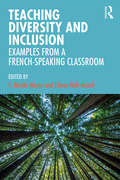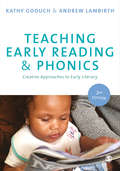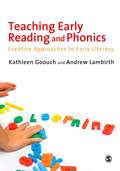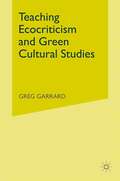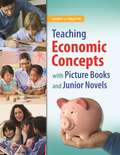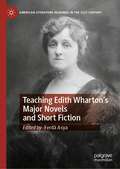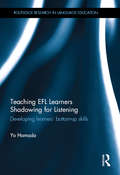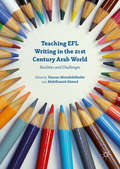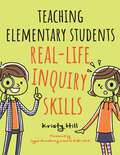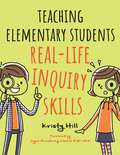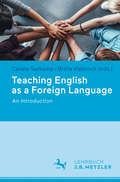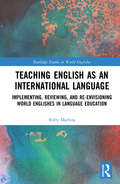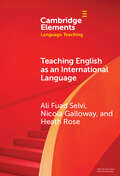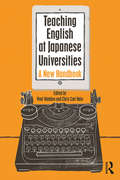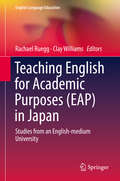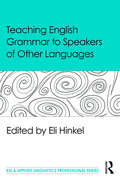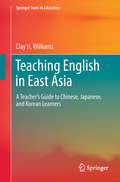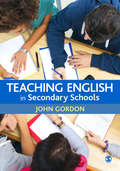- Table View
- List View
Teaching Diversity and Inclusion: Examples from a French-Speaking Classroom
by E. Nicole MeyerTeaching Diversity and Inclusion: Examples from a French-Speaking Classroom explores new and pioneering strategies for transforming current teaching practices into equitable, inclusive and immersive classrooms for all students. This cutting-edge volume dares to ask new questions, and shares innovative, concrete tools useful to a wide variety of classrooms and institutional contexts, far beyond any disciplinary borders. This book aims to instill classroom approaches which allow every student to feel safe to share their truth and to reflect deeply about their own identity and challenges, discussing course design, assignments, technologies, activities, and strategies that target diversity and inclusion in the French classroom. Each chapter shares why and how to design an inclusive community of learners, including opportunities to promote interdisciplinary approaches and cross-disciplinary collaborations, exploring cultures and underrepresented perspectives, and distinguishing unconscious biases. The essays also provide theoretical and practical strategies adaptable to any reflective teacher desiring to create a welcoming, inclusive classroom that draws in students they might not otherwise attract. This long overdue work will be ideal for both undergraduate and graduate students and administrators seeking fresh approaches to diversity in the classroom.
Teaching Diversity and Inclusion: Examples from a French-Speaking Classroom
by E. Nicole Meyer Eilene Hoft-MarchTeaching Diversity and Inclusion: Examples from a French-Speaking Classroom explores new and pioneering strategies for transforming current teaching practices into equitable, inclusive and immersive classrooms for all students. This cutting-edge volume dares to ask new questions, and shares innovative, concrete tools useful to a wide variety of classrooms and institutional contexts, far beyond any disciplinary borders. This book aims to instill classroom approaches which allow every student to feel safe to share their truth and to reflect deeply about their own identity and challenges, discussing course design, assignments, technologies, activities, and strategies that target diversity and inclusion in the French classroom. Each chapter shares why and how to design an inclusive community of learners, including opportunities to promote interdisciplinary approaches and cross-disciplinary collaborations, exploring cultures and underrepresented perspectives, and distinguishing unconscious biases. The essays also provide theoretical and practical strategies adaptable to any reflective teacher desiring to create a welcoming, inclusive classroom that draws in students they might not otherwise attract. This long overdue work will be ideal for both undergraduate and graduate students and administrators seeking fresh approaches to diversity in the classroom.
Teaching Early Reading and Phonics: Creative Approaches to Early Literacy
by Kathy Goouch Andrew LambirthThis book supports teachers using phonics in their teaching of early reading. The authors show how important it is to ensure that children acquire a wide range of reading strategies, while also setting out practical 'pointers' which will enable teachers to translate the theory into effective practice. Readers will learn: - How to plan phonics within a rich, interactive and playful literacy pedagogy - How to construct relationships with the young readers in their classes and the texts around them - How to embed the teaching of phonics in carefully selected high quality materials - particularly in children's literature. Written for practicing teachers, student teachers on initial teacher training courses at undergraduate and postgraduate levels, the book will also be useful for advisors working on continuing professional development. Dr Kathy Goouch and Dr Andrew Lambirth are based at Canterbury Christ Church University in the field of early and primary education and literacy.
Teaching Early Reading and Phonics: Creative Approaches to Early Literacy
by Kathy Goouch Andrew LambirthLearning to read is an exciting and vital part of every child&’s development. The new edition of this book continues to provide trainees and teachers with a broad understanding of teaching reading and phonics, and equip them with the skills necessary to face the reality of the early years classroom in order to meet the needs of individual children. With vital information on constructing relationships with young readers, and how to plan phonics within a rich, interactive and playful literacy pedagogy, the second edition now includes: A brand new chapter on babies and early reading More information on language acquisition and how children learn A discussion of children with SEN An appreciation for the rise of digital technologies in relation to reading Whether you're training to become a teacher, or already working in the classroom this book is ideal for those who wish to embed the teaching of phonics into carefully selected high quality materials - particularly in children's literature.
Teaching Early Reading and Phonics: Creative Approaches to Early Literacy
by Andrew Lambirth Kathy GoouchThis book supports teachers using phonics in their teaching of early reading. The authors show how important it is to ensure that children acquire a wide range of reading strategies, while also setting out practical 'pointers' which will enable teachers to translate the theory into effective practice. Readers will learn: - How to plan phonics within a rich, interactive and playful literacy pedagogy - How to construct relationships with the young readers in their classes and the texts around them - How to embed the teaching of phonics in carefully selected high quality materials - particularly in children's literature. Written for practicing teachers, student teachers on initial teacher training courses at undergraduate and postgraduate levels, the book will also be useful for advisors working on continuing professional development. Dr Kathy Goouch and Dr Andrew Lambirth are based at Canterbury Christ Church University in the field of early and primary education and literacy.
Teaching Ecocriticism and Green Cultural Studies
by Greg GarrardEcocriticism is one of the most vibrant fields of cultural study today, and environmental issues are controversial and topical. This volume captures the excitement of green reading, reflects on its relationship to the modern academy, and provides practical guidance for dealing with global scale, interdisciplinarity, apathy and scepticism.
Teaching Economic Concepts with Picture Books and Junior Novels
by Nancy J. PoletteUsing quality literature to introduce younger students to economic terms and concepts is an engaging and effective teaching method. This book demonstrates how.At what age can children benefit from learning about economics? The consensus among educators today is the earlier the better. K–8 teachers and librarians will find this book invaluable for introducing basic economic concepts to students and giving them a solid foundation of understanding that can be built upon as they advance in grade level. Author Nancy Polette, prolific author and expert on using picture books for education, explains how to use 20 picture books to present basic ideas such as credit, wants and needs, and supply and demand; and to build understanding of more complex concepts with 20 junior novels. The titles and suggested activities enable students to enjoy the literary experience and benefit from economic lessons that sink in because they are presented through stories involving characters with whom children can relate.
Teaching Economic Concepts with Picture Books and Junior Novels
by Nancy J. PoletteUsing quality literature to introduce younger students to economic terms and concepts is an engaging and effective teaching method. This book demonstrates how.At what age can children benefit from learning about economics? The consensus among educators today is the earlier the better. K–8 teachers and librarians will find this book invaluable for introducing basic economic concepts to students and giving them a solid foundation of understanding that can be built upon as they advance in grade level. Author Nancy Polette, prolific author and expert on using picture books for education, explains how to use 20 picture books to present basic ideas such as credit, wants and needs, and supply and demand; and to build understanding of more complex concepts with 20 junior novels. The titles and suggested activities enable students to enjoy the literary experience and benefit from economic lessons that sink in because they are presented through stories involving characters with whom children can relate.
Teaching Edith Wharton’s Major Novels and Short Fiction (American Literature Readings in the 21st Century)
by Ferdâ AsyaThis book translates recent scholarship into pedagogy for teaching Edith Wharton’s widely celebrated and less-known fiction to students in the twenty-first century. It comprises such themes as American and European cultures, material culture, identity, sexuality, class, gender, law, history, journalism, anarchism, war, addiction, disability, ecology, technology, and social media in historical, cultural, transcultural, international, and regional contexts. It includes Wharton’s works compared to those of other authors, taught online, read in foreign universities, and studied in film adaptations.
Teaching EFL Learners Shadowing for Listening: Developing learners' bottom-up skills (Routledge Research in Language Education)
by Yo HamadaShadowing, an active and highly cognitive technique for EFL listening skill development, in which learners track heard speech and vocalize it simultaneously, is gradually becoming recognized. However, there remain a lot of mysteries and misunderstandings about it. This book uncovers shadowing in terms of theory and practice. This book cements shadowing as a separate technique from other similar techniques such as Elicited Imitation, Mirroring, and simple repetition, and provides ample empirical data to explain the function of Shadowing. It also elaborates on how Shadowing should be used in terms of materials, procedure, and learners’ psychology, which would aid in instructors’ use of Shadowing in teaching. A guide on a method effective in improving learners’ bottom-up listening skills, this book will certainly prove useful to English Language learners and instructors in their linguistic pursuits.
Teaching EFL Learners Shadowing for Listening: Developing learners' bottom-up skills (Routledge Research in Language Education)
by Yo HamadaShadowing, an active and highly cognitive technique for EFL listening skill development, in which learners track heard speech and vocalize it simultaneously, is gradually becoming recognized. However, there remain a lot of mysteries and misunderstandings about it. This book uncovers shadowing in terms of theory and practice. This book cements shadowing as a separate technique from other similar techniques such as Elicited Imitation, Mirroring, and simple repetition, and provides ample empirical data to explain the function of Shadowing. It also elaborates on how Shadowing should be used in terms of materials, procedure, and learners’ psychology, which would aid in instructors’ use of Shadowing in teaching. A guide on a method effective in improving learners’ bottom-up listening skills, this book will certainly prove useful to English Language learners and instructors in their linguistic pursuits.
Teaching EFL Writing in the 21st Century Arab World: Realities and Challenges
by Abdelhamid Ahmed Hassan AbouabdelkaderTeaching EFL Writing in the 21st Century Arab World addresses a range of issues related to researching and teaching EFL writing in different countries in the Arab World including Egypt, Morocco, Oman, Palestine, Tunisia, UAE and Yemen. Both theoretically and practically grounded, chapters within discuss the different contexts in which EFL writing is taught, from primary school to university. The book sheds light on how EFL writing is learned and taught at each educational stage, exposing the different challenges encountered in the teaching and learning. The focus on EFL writing in the Arab World makes this a unique and long overdue contribution to the field of research around EFL writing and will be an invaluable resource for researchers, curriculum designers and students.
Teaching Elementary Students Real-Life Inquiry Skills
by Kristy HillFake news and misinformation is everywhere. Learn how to teach elementary students to locate reliable information, evaluate sources, and develop their writing skills in the classroom and in the library.Empower students to find and evaluate information with this practical guide to supporting classroom writing and research instruction. You'll learn ways to teach students to evaluate information for accuracy and to collect information from credible sources such as library journals. Additionally, you'll learn how to incorporate writing into your makerspace, encourage curiosity through the inquiry process, and help students to find their voice. Along the way, you'll discover how to support various writing genres including technical writing and the research project and how to teach prewriting for digital media such as websites, blogs, and social media.Lesson plans, which can be adapted from year to year as a part of the classroom and library curriculum, explain how students can use databases, search engines, books, and expert testimony to gather information. Also included are student samples and hands-on activities that will get students excited about learning.
Teaching Elementary Students Real-Life Inquiry Skills
by Kristy HillFake news and misinformation is everywhere. Learn how to teach elementary students to locate reliable information, evaluate sources, and develop their writing skills in the classroom and in the library.Empower students to find and evaluate information with this practical guide to supporting classroom writing and research instruction. You'll learn ways to teach students to evaluate information for accuracy and to collect information from credible sources such as library journals. Additionally, you'll learn how to incorporate writing into your makerspace, encourage curiosity through the inquiry process, and help students to find their voice. Along the way, you'll discover how to support various writing genres including technical writing and the research project and how to teach prewriting for digital media such as websites, blogs, and social media.Lesson plans, which can be adapted from year to year as a part of the classroom and library curriculum, explain how students can use databases, search engines, books, and expert testimony to gather information. Also included are student samples and hands-on activities that will get students excited about learning.
Teaching English as a Foreign Language: An Introduction
by Carola Surkamp Britta ViebrockDiese Einführung in englischer Sprache präsentiert in 14 Kapiteln die grundlegenden Themen und Gegenstandsbereiche der Englischdidaktik. Gleichermaßen praxisnah wie theoretisch fundiert, behandelt der Band zentrale Prinzipien und Kompetenzbereiche eines modernen Fremdsprachenunterrichts. Ausgehend von den zentralen Akteur/innen (Lehrende und Lernende) und mit Blick auf die Teilbereiche der Sprach-, Literatur- und Kulturdidaktik werden zudem Vorschläge für den Einsatz unterschiedlicher Materialien und Medien diskutiert. Weitere Kapitel widmen sich den institutionellen Organisationsstrukturen und dem Bereich Assessment/Diagnose. Der Band erscheint in zweifarbiger Gestaltung, mit Definitionen und Beispielen sowie mit zahlreichen Abbildungen.This comprehensive introduction presents the fundamental topics and issues of TEFL (Teaching English as a Foreign Language) in 14 chapters. Integrating both profound theoretical and creative practical considerations, the central principles and competence domains of modern foreign language teaching are discussed. Starting with the main classroom agents (teachers and learners), the chapters outline a variety of content areas (language, literature, cultural issues) and thoroughly review materials, media and methods. Additional chapters are concerned with the historical development of English language teaching, its current institutional organisation as well as assessment and evaluation.
Teaching English as an International Language: Implementing, Reviewing, and Re-Envisioning World Englishes in Language Education (Routledge Studies in World Englishes)
by Roby MarlinaHow do teachers inspire students to learn to appreciate different Englishes? Has anyone tried to teach world Englishes? If so, what do they do and how do they feel about it? Most importantly, do students see the benefits in learning about world Englishes? This book responds to these questions by 1) offering a clear and solid foundation for the development of English as an International Language (EIL)-oriented curricula in an English Language program and a teacher education program, 2) critically reviewing the current pedagogical principles and practices of teaching EIL, and 3) offering an alternative way of conceptualising and teaching EIL. Using a three-year undergraduate program of EIL in an Australian university as a research site, this book provides a detailed account of actual classroom practices that raise students’ awareness of world Englishes and engage them in learning how to communicate interculturally. This book is the first of its kind that explores the teaching of EIL in a country where English is a predominant and national language.
Teaching English as an International Language: Implementing, Reviewing, and Re-Envisioning World Englishes in Language Education (Routledge Studies in World Englishes)
by Roby MarlinaHow do teachers inspire students to learn to appreciate different Englishes? Has anyone tried to teach world Englishes? If so, what do they do and how do they feel about it? Most importantly, do students see the benefits in learning about world Englishes? This book responds to these questions by 1) offering a clear and solid foundation for the development of English as an International Language (EIL)-oriented curricula in an English Language program and a teacher education program, 2) critically reviewing the current pedagogical principles and practices of teaching EIL, and 3) offering an alternative way of conceptualising and teaching EIL. Using a three-year undergraduate program of EIL in an Australian university as a research site, this book provides a detailed account of actual classroom practices that raise students’ awareness of world Englishes and engage them in learning how to communicate interculturally. This book is the first of its kind that explores the teaching of EIL in a country where English is a predominant and national language.
Teaching English as an International Language (Elements in Language Teaching)
by null Ali Fuad Selvi null Nicola Galloway null Heath RoseThis Element offers a comprehensive account of the unprecedented spread of English as a global language by taking historical, sociolinguistic, and pedagogical perspectives. To realize this mission, it opens with an accessible discussion of the historical trajectory of the English language with qualitative and quantitative connections to its contemporary diversity in terms of forms, roles, functions, uses, users, and contexts of English as a global and multilingual franca. Built upon this synchronic-diachronic symbiosis, the discussion is complemented by an overview of major analytical paradigms and trends that promote systematical scrutiny of the English language and its sociolinguistic and educational implications. It ends by showcasing instructional practices, recommendations, reflective questions, and future directions for language educators to revamp their beliefs, commitments, and practices considering the changing needs and realities of the present-day global sociolinguistic ecology and individuals therein.
Teaching English at Japanese Universities: A New Handbook
by Paul Wadden Chris Carl HaleWritten by leading English-language educators in Japan, this Handbook provides an in-depth guide for the new generation of teachers at Japanese universities. In clear, accessible prose, it offers practical and detailed advice on effective classroom pedagogy, student motivation, learning styles, classroom culture, national language policy, career opportunities, departmental politics, administrative mindset, and institutional identity. Its four sections—The setting, The courses, The classroom, and The workplace—examine issues faced by university language teachers as well as challenges confronted by the increasing number of scholars teaching English as a Medium of Instruction (EMI) and Content and Language Integrated Learning (CLIL) courses. Firmly grounded in contemporary teaching method and theory, the Handbook’s 23 chapters also acknowledge the influence of diverse movements such as World Englishes, global issues, gender, and positive psychology. Its three appendices contain information on organizations, books, journals, and websites particularly useful for Japanese university educators; explanation of types and rankings of schools; ways to learn more about individual institutions for job-hunting; and detailed information on the structure (and Japanese titles) of faculty and non-teaching staff at the typical university. This Handbook is an invaluable resource for anyone teaching, or aspiring to teach, at a Japanese university.
Teaching English at Japanese Universities: A New Handbook
by Paul Wadden Chris Carl HaleWritten by leading English-language educators in Japan, this Handbook provides an in-depth guide for the new generation of teachers at Japanese universities. In clear, accessible prose, it offers practical and detailed advice on effective classroom pedagogy, student motivation, learning styles, classroom culture, national language policy, career opportunities, departmental politics, administrative mindset, and institutional identity. Its four sections—The setting, The courses, The classroom, and The workplace—examine issues faced by university language teachers as well as challenges confronted by the increasing number of scholars teaching English as a Medium of Instruction (EMI) and Content and Language Integrated Learning (CLIL) courses. Firmly grounded in contemporary teaching method and theory, the Handbook’s 23 chapters also acknowledge the influence of diverse movements such as World Englishes, global issues, gender, and positive psychology. Its three appendices contain information on organizations, books, journals, and websites particularly useful for Japanese university educators; explanation of types and rankings of schools; ways to learn more about individual institutions for job-hunting; and detailed information on the structure (and Japanese titles) of faculty and non-teaching staff at the typical university. This Handbook is an invaluable resource for anyone teaching, or aspiring to teach, at a Japanese university.
Teaching English for Academic Purposes: Studies from an English-medium University (English Language Education #14)
by Rachael Ruegg Clay WilliamsThis book focuses on appropriate English for Academic Purposes instructional concepts and methods in the Japanese context. It investigates a variety of pedagogical techniques, addressing the fundamental academic English skills – listening, speaking, reading and writing – as well as assessment and materials development. All the research included was conducted in Japanese university settings, thus shedding new light on the effective implementation of EAP teaching and learning activities with Japanese learners of English. This book is of interest to anyone working in an EAP context at the secondary or tertiary level, especially those which include Japanese learners.
Teaching English Grammar to Speakers of Other Languages (ESL & Applied Linguistics Professional Series)
by Eli HinkelThis practical and research-based introduction to current and effective English grammar instruction gives pre-service and in-service teachers and teacher educators a strong foundation for teaching second language grammar and helps them develop their professional knowledge and skills. Written in a highly readable style for an international audience, it provides a thorough and rounded overview of the principles, strategies, techniques, and applications currently dominant in teaching L2 grammar in a range of instructional settings around the world. Chapter authors are world-class authorities in grammar and grammar teaching and learning. All chapters are based on theoretical frameworks and/or research foundations with a strong emphasis on practical applications and implications for classroom teaching, and highlight teaching methods, key concepts, and terminology associated with grammar instruction. Illuminating the options and choices in grammar teaching from a contemporary perspective, Teaching English Grammar to Speakers of Other Languages is ideal as key text for students in undergraduate and graduate MA-TESOL programs and as a resource for practicing ESL/EFL teachers, teacher educators, and teaching faculty.
Teaching English Grammar to Speakers of Other Languages (ESL & Applied Linguistics Professional Series)
by Eli HinkelThis practical and research-based introduction to current and effective English grammar instruction gives pre-service and in-service teachers and teacher educators a strong foundation for teaching second language grammar and helps them develop their professional knowledge and skills. Written in a highly readable style for an international audience, it provides a thorough and rounded overview of the principles, strategies, techniques, and applications currently dominant in teaching L2 grammar in a range of instructional settings around the world. Chapter authors are world-class authorities in grammar and grammar teaching and learning. All chapters are based on theoretical frameworks and/or research foundations with a strong emphasis on practical applications and implications for classroom teaching, and highlight teaching methods, key concepts, and terminology associated with grammar instruction. Illuminating the options and choices in grammar teaching from a contemporary perspective, Teaching English Grammar to Speakers of Other Languages is ideal as key text for students in undergraduate and graduate MA-TESOL programs and as a resource for practicing ESL/EFL teachers, teacher educators, and teaching faculty.
Teaching English in East Asia: A Teacher’s Guide to Chinese, Japanese, and Korean Learners (Springer Texts in Education)
by Clay H. WilliamsThis book investigates the current EFL market in East Asia, focusing on K-12, university, and cram school English education in Japan, China, and Korea. It explores prevailing educational practices by both Asian learners and teachers of English, contrasting them with Western practices, and illuminating why Western pedagogical methods have often encountered tremendous resistance from teachers, administrators, parents, and students in the East Asian classroom context. After establishing this cultural contrast of pedagogical norms, the book presents a series of practical means for adapting Western teaching practices and philosophies to better suit the learning styles of East Asian students and the cultural context and practical realities of the East Asian classroom, offering both Western teachers working in East Asia and native East Asian teachers realistic plans for turning theory into successful practice. These plans are divided by subsections, focusing on the linguistic subskills being taught: listening/speaking, reading, and writing. Each section includes two contrasting lesson plans to demonstrate how the educational theories and practices promoted by the author can often be implemented by making relatively simple changes to existing practices that incorporate a fuller understanding of how to actively assist students in developing new learning styles and behaviors.
Teaching English in Secondary Schools
by John GordonThis book is an indispensable guide for anyone training to become a secondary English teacher. It provides an overview of the main topics taught in schools, informed by good teaching practice drawn from the classroom and supported by research and theory, and engages with the requirements of the 2014 National Curriculum for England. Each chapter is based around a ‘lesson feedback’ case study informed by real classroom observations combined with research findings to explore and analyse what underpins high quality English teaching. Coverage includes: · Encouraging a love of reading in your classroom · How to teach effective writing for pleasure and for information · Developing students’ grammar, vocabulary and spoken English · Inspiring teaching using drama, poetry and Shakespeare · Intelligent use of media and new literacies in teaching This is essential reading on all secondary English initial teacher education courses, including school-based (SCITT, School Direct, Teach First), university-based (PGCE) and employment-based routes into teaching.
